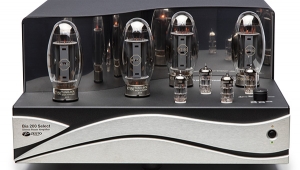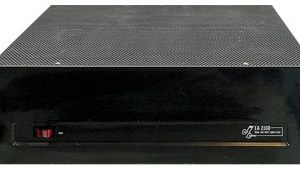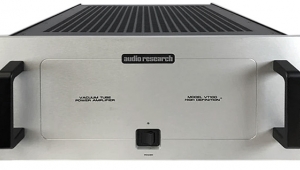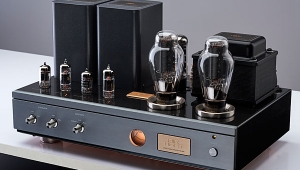| Columns Retired Columns & Blogs |
Cary Audio Design CAD-805 monoblock power amplifier Sam Tellig August 2003
Sam Tellig wrote again about the CAD-805 in August 2003 (Vol.26 No.8):
Footnote 1: Cary Audio Design, 1020 Goodworth Drive, Apex, NC 27539. Tel: (919) 355-0010. Fax: (919) 355-0013. Web: www.caryaudio.com.
"If either of these amplifiers is RIGHT...the other must be WRONG."
Editor John Atkinson wrote that cover line for our January 1994 issue (Vol.17 No.1). Two amps shared the cover. Each was reviewed inside.
Dick Olsher, aka Toob Man, did the honors for the Cary CAD-805, while Thomas J. Norton considered the solid-state Krell KSA-300S. TJN performed test-bench measurements on both amps.
The face-off was fascinating: Subjective vs objective. Tube vs solid-state. Retro vs modern. Monoblock vs two-channel.
"These Krells are the best-sounding preamplifier and power amplifier I have heard in my system," Tom trumpeted after measuring the KSA-300S (he auditioned it with the matching KRC preamp). He commended the amplifier's "very fine" test-bench results.
As for the Cary CAD-805, TJN called its test-bench results "mediocre." He summed up his feelings thus:
"The CAD-805's somewhat nostalgia-inducing design is reinforced by its measured performance—an updated nostalgia, to be sure, but updating can only bring us so far in what is basically a half-century-old design concept, one long since abandoned for what would appear to be very good objective reasons."
But DO didn't surrender to Major Tom:
"Admittedly, this 211-based, single-ended amplifier is not a stellar test-bench performer. Yet, equipped only with a sophisticated integrated test and evaluation system (ie, two ears), any audiophile worth his or her salt should have no problem discerning the 805's magic."
As editor, what was JA to do? If one amp was right, the other must be wrong. Right?
Not so fast. "Both these amplifiers might be right," I suggested to The Chief, shortly after the reviews ran. There was an advantage to having been an English major at college, I explained. I can hold two opposing beliefs at the same time—thanks to a tolerance of "cognitive dissonance," imparted by none other than T.S. Eliot.
Don't get me wrong—some amplifiers are obviously more right or wrong than others, by objective or subjective standards. Some amplifiers even manage to measure well and sound good at the same time. But, as one European amplifier designer with an advanced degree in electrical engineering once told me, this business of one approach to amplifier design being right and another being wrong doesn't work for him.
For instance, he continued, a circuit could work well on paper and measure superbly on the test bench but not please the ear. Another circuit might measure less well but sound far better. And two amplifiers that use totally different topologies might sound equally right. Or wrong.
Another amplifier designer told me he "reckoned" that all amplifiers are wrong in that none gets close to reproducing—or re-creating—the sound and experience of a live musical event, especially the dynamics. Musical perfection is an elusive goal, he said, that always slips infinitesimally out of reach. But a designer could get ever closer to that elusive perfection.
"[T]he perfect amplifier would leave no evidence of its existence other than the fact that the varying voltage representing the music signal has been made larger, resulting in truly musical sound from your speakers," wrote JA in that very same, January 1994, issue of Stereophile.
But as soon as you try to make the music signal larger, things happen. Distortions creep in—through the mains, through the power supply, through mechanical vibrations (as Yves-Bernard André has demonstrated), and a host of other ways. Maybe, to achieve a "truly musical sound," one should aim for good distortions that help battle the bad ones. It's not Yves-Bernard's point of view or, obviously, TJN's or JA's. I'm not even sure it's ST's point of view. Ask me tomorrow.
That "cognitive dissonance" crap wouldn't cut it in Apex, North Carolina, the town outside Cary where Cary Audio Design is now located, so I didn't bring it up with Cary's Dennis Had (footnote 1).
Dennis likes to try things. He has produced dozens of different designs, mostly tubed. He's made flea-powered single-ended amps and high-powered push-pull workhorses. He sells assembled amps and kits. I'm not sure if Dennis could do this if he believed that one design made all others wrong.
It's always fun to talk with Dennis. One time he phoned me all aroused about an inexpensive speaker he'd bought at RadioShack, while his wife, Donna, was busy shopping at the mall. You do this to the speaker, you do that to it, he explained. The result, he swore, was wonderful. "Nothing like a good, cheap 15" paper-cone woofer," he assured me.
I've had my fun in return.
"Your amps are too powerful, Dennis! Never mind 8W, 10W. How about 3W, 5W? The less an amp amps the better the amp will be." This led Dennis to design his SE-2A3 monoblock, a 5W wonder that was probably ahead of its time. Hey, Dennis, bring it back with the new 2.5V TJ Mesh Plate 300B tubes!
If you ask Dennis about his favorite amp, he'll usually name the CAD-805. More than any other, that's the amplifier that helped put Cary Audio Design on the map. And more than any other, that's the amp that helped bring single-ended triodes (SETs) into the mainstream, as much as any high-end audio product can be called "mainstream."
The very amp that had at least a 50-50 chance of being "WRONG," according to that January 1994 cover line, is still around—updated and improved—after a decade. Too bad Tom Norton is now so busy as editor of Stereophile Guide to Home Theater, or he could put the Cary CAD-805 Anniversary Edition monoblock power amp through its test-bench paces. A return to retro, and déjà vu all over again. Krell amps are still flourishing, too—likewise, better than ever—[though the KSA-300S is long discontinued.—Ed.].
The CAD-805 started out, in 1993, at $7495/pair, and the Anniversary Edition costs $11,000/pair—which means the price has gone up by less than half over a decade. Not bad, considering inflation and product enhancements.
Now you get a chassis and top plate finished in Jaguar Anthracite Black, with a clear-coat finish. The old girl looks better than ever—like a vintage car tricked out to perfection. This amp has been detailed.
Some history might be appropriate on this 10th Anniversary occasion, which I'm sure TJN will celebrate, too:
The CAD-805 got its name from the single 805 output tube around which it was designed. This radio transmitter tube might have scared potential customers with its anode plate cap, So Dennis Had quickly replaced it with a hatless 211 radio transmitter tube, a variety he knew well from his years in ham radio. This was the version that DO and TJN had the food fight over in January '94.
The original CAD-805 had four tubes—three in the signal path. Starting as the signal came in, a single 6SL7 dual-triode input tube provided voltage gain. This was coupled to the control grid of an EL34 pentode tube wired as a triode. The EL34 produced about 4W of audio power to drive the control grid of the 805 or 211 via an interstage transformer. This was how the CAD-805 made it up to its rated power of 50W, more or less.
The amplifier operated in class-A1 up to about 25W, capacitor-coupled, the EL34 delivering no grid current to the output tube. Beyond 25W, the drive signal from the interstage transformer kicked in, sliding the amp into class-A2 and causing the output tube's grid to turn positive and draw current. As power went up, so did distortion, and the 805 or 211 output tube became less and less linear.
I think this nonlinearity is what caused TJN to consider going out and buying a Krell. Meanwhile, most Cary listeners might be so jammin' by the time the CAD-805 pushed into class-A2 that they might never notice the increased distortion.
The fourth tube—the one that really caught the eye—is the 1629/6UT "cat's eye" in the center of the amp's faceplate. Dennis once told me that the tube was there for entertainment.
"This tube's fluorescent target indicates the effects of a voltage change," he explained. "The target operates at a positive voltage and so draws electrons from the cathode. When the electrons strike the target, they produce a glow on the fluorescent coating. When the eye is completely closed, you're at full power."
More changes were to follow.
Just as DO's review appeared, Dennis changed the driver tube from an EL34 to a 300B. The output tube remained the same until the CAD-805C, introduced in January 1997, when the 211 was replaced with an equally venerable 845. I caught up with this version a year later, in March 1998 (Vol.21 No.3).
One of the things that struck me immediately about the "C" version was the 805's immediacy and soundstaging. Perhaps turning to the 845 output tube had something to do with the 805C's spectacular spaciousness. Dennis sure thought it did.
The Cary CAD-805C was magic. Even JA thought so—not that 50-50 John let on so quickly. But by November 2002, his grid current had turned positive. JA selected the Cary CAD-805 as one of the 100 greatest hi-fi products of the past 40 years: "While not the first modern tube amplifier with a single-ended output stage, Dennis Had's gorgeous-looking and -sounding '805 is the culmination of all that this retro technology has to offer," he wrote.
The "retro" (heh-heh) CAD-805 was tied for 37th place with the Halcro dm58 monoblock power amp. In fairness, a Krell amp—the original KSA-100—made the list, too, tied for 16th place. I might have selected the KSA-50 or KSA-80.
The CAD-805's Tenth Anniversary Edition is old and improved—rather like me. I mentioned the Jaguar Anthracite Black finish. This alone might be worth a thousand bucks. But there are other enhancements.
Up until the "C" version, the CAD-805 needed a lot of input voltage for full output. You definitely needed an active preamp to get the most from this amp. Now, according to Dennis, there are basically two input stages. The first 6SN7 tube—not a 6SL7—acts as an "onboard preamp," he told me. The second 6SN7 works as a low-impedance driver to run the 300B. The result: more gain. The Cary CAD-805 Anniversary Edition requires only 0.75V drive for full output.
Both 845 and 211 output tubes are provided as standard. The user can have fun with both and then choose—all that's required is to set the switch on the top left of the amplifier. With the 845, Dennis says, the CAD-805 will deliver 50W. With the 211, the amp is good for up to 70W. But when you switch tubes, take care that the output tubes have fully cooled down, which can take up to half an hour. And be certain the amplifier is off—ie, unplugged. You can not change output tubes on the fly.
The driver tube is a 300B, its bias set at the factory to 60 milliamps. The user should check this in his or her own setting. Line voltages, of course, can vary. If you change 300B tubes, you have to re-bias. A very elegant, analog bias meter is provided. No re-biasing is necessary when going from an 845 to a 211 output tube, or vice versa. My review samples came with TJ Meshplate 300B tubes (the 5V version) manufactured in China, as opposed to Western Electric 300B tubes made in the US.
I didn't have a chance to use the review pair with WE 300Bs, but my experience with the TJ tubes was such that I didn't feel shortchanged. The TJs have received some acclaim on Internet bulletin boards. In the Cary CAD-805 Anniversarys they sounded sweet, dynamic, and detailed. They were also very quiet.
"The front portion of the CAD-805 is, in essence, a 300B single-ended amplifier," said Dennis. "The sound of a 211 or 845 output tube is different from that of the 300B—less elegant. But we get close to the absolute purity of the 300B because we're using that tube as a driver.
"There is one thing that the CAD-805 does that's superior to a 300B-based amp. The CAD-805 produces life-size images. It makes everything huge. If you then go back to an amp that uses the 300B as an output tube, then I think you'll miss that life-size image."
I asked Dennis what accounts for that life-size image.
"The greater power of the 211 or 845 output tube, as opposed to a 300B, as we discussed. But also the lack of feedback. In order to produce life-size images in your home, the No.1 requirement is that there be no feedback of any nature.
"The reason I originally put the feedback-control switch on the 805 is to show people the negative effects of negative feedback in terms of the presentation. A tube amp should not have feedback. If engineering practices are followed in a proper design fashion, there is no reason for feedback. But then people ask, 'How are you going to lower the output impedance?' Well, you don't!
"Let's talk in terms of a bass guitar or a kettle drum, or a piano for that matter. When you hear it live, it doesn't just attack and stop. There is decay. With feedback, you lose the decay. Purists will say that you need to control that bass driver. Well, yes and no. You can over-control it and lose the decay and room effects."
Other features of the CAD-805 Anniversary Edition include a "new and improved" output transformer "to yield full bandwidth coverage at full power output." According to Dennis, the 805 Anniversary "plays deeper bass with more driver control"—a claim quickly verified with my review pair of Triangle Magellan speakers. Snazzy WBT speaker binding posts are supplied as standard.
The 805 Anniversary has outputs for 4, 8, and 16 ohm speakers. I'm not sure there are many 16 ohm speakers these days, but the tap is there to try—and who knows what you might hear? Don't necessarily assume that a nominal "8 ohm" speaker will sound best off the 8 ohm tap.
The CAD-805 arrived with good timing—except, perhaps, for the lack of Western Electric 300B driver tubes. When I receive them, I'll write a Follow-Up. Meanwhile, I'm in no hurry to return the TJ Meshplates.
I had several preamps on hand, but decided to use my passive Purest Audio Systems P500SE "preamp." My CD player, for the most part, was the Musical Fidelity Tri-Vista. Analog took a brief vacation in our living room—but not for long! Speakers, until I had to surrender them, were the Triangle Magellans—a $32,900/pair luxury. I ran the amplifiers in, playing music, for at least 100 hours. I won't obsess about interconnects and cables—catch as catch can.
Even before the amplifiers had been run in, I heard that typical single-ended harmonic purity and immediacy. It's hard to put one's finger—or test-bench thumb—on the single-ended sound, but it's distinctive and somehow very musical. Single-ended tends to sound less contrived—less like hi-fi and more like music. Every audiophile worth his or her salt should spend some time listening to, if not owning, SETs.
What a great single-ended triode amp can deliver is a certain sense of ease—related, I'm sure, to its harmonic presentation. It's as if all the harmonics are precisely in register. A SET amp vs a push-pull design can be like listening to the Chicago or Boston Symphony as opposed to a second- or third-rate ensemble. The timing is just right. And by that, I do not mean tapping toes, but rather that harmonics seem to be in proper register, as they are in real life. Ella Fitzgerald, Louis Armstrong, Bing Crosby, Jascha Heifetz can rise from their graves and play for you live. That's the magic of single-ended triode. The magic of the CAD-805 Anniversary was that it supplied this magic, along with enough power to drive most loudspeakers in most rooms.
Single-ended power seems different from push-pull power—whatever the test-bench measurements say. Take a 50W conventional push-pull tube amp and play it alongside the 50W CAD-805 Anniversary and I think you'll hear what I mean. The Cary sounds big. Very big. Rather like a 150W or 200W push-pull tube amp.
SET amps tend to fill in and flesh out the sound—even with vintage recordings. It's simply amazing how good some of those Bing Crosby or Duke Ellington recordings from the late 1930s can sound. Or your Elvis or Buddy Holly recordings from the '50s.
Single-ended amplifiers tend to handle microdynamics particularly well—those subtle differences or shadings in dynamics. Perhaps some flea-powered SET amps better the CAD-805 Anniversary in this regard, but not by much. Meanwhile, the flea-powered amps, while sounding more immediate, can also sound dynamically constrained.
I think where the CAD-805 Anniversary improves over previous versions is in its ability to stretch the magic of SETs—to provide the immediacy, delicacy, and microdynamic magic of the flea-powered wonders with enough power so that one is not limited to super-sensitive loudspeakers. It will be interesting to find out how very-high-sensitivity speakers fare with the CAD-805 Anniversarys, however.
The CAD-805 Anniversary improves on the CAD-805C, which I owned for several years, in another respect: bass performance. The bass now seems more extended and tight. The CAD-805 Anniversarys could deliver the bass notes with the Magellans with great authority, if not the ultimate control of a big solid-state amp. If you want everything, go to a concert.
I cranked up conductor Paavo Järvi's recording of Berlioz's Symphonie Fantastique (Telarc SACD-60578). The Carys opened up, spatially and dynamically—with better bass control than I remember from the CAD-805C. Sure, I loved the sound of my Sun Audio SV-2A3, rated at 3.5Wpc, too. But while the Sun could shine at low to moderate volume levels, the Cary CAD-805 Anniversarys could really open up. I know, I'm comparing different types of amps at different prices. And I do love the Sun—even though it's been dropped from "Recommended Components."
Like the Sun—okay, maybe almost like the Sun—the CAD-805 Anniversary clearly showed the superiority of SACD over CD. Assuming you can get anything on SACD worth listening to. Assuming the SACD was well-recorded. Assuming the performance venue and the musicians could yield a great performance. Assuming yadda yadda yadda. Some SACDs, including some classical releases, sound pretty crappy.
One that does not is a disc that features violinist Yesko Eschkenazy and conductor Mario Boni with the Concertgebouw Chamber Orchestra (PentaTone PTC 5186 001). The works are by Mozart, Schubert, and Mendelssohn. With the Musical Fidelity Tri-Vista SACD/CD player and the CAD-805 Anniversary, the violinist was just...there.
Shortly before I completed this column, Richard Kohlruss, of VMax Services, came to collect the Triangle Magellans and ship them to the Home Entertainment 2003 show. My wife, Marina, was especially sad to see them leave.
"The whole house looks empty," she said.
Indeed it did.
In place of the Magellans, I had the JMlab Cobalt 8166 speakers—small floorstanders that stand 38.5" high and cost $1895/pair. Of course, they sounded smaller than the Magellans; and, for a few days, it was difficult to get accustomed. But the CAD-805 Anniversarys seemed to make this small speaker seem much bigger than it is.
I had fun with the CAD-805 Anniversarys, and I expect to have even more fun with them in the months to come. I especially enjoyed being able to switch between the 845 and 211 output tube—"a doddle," as the British like to say, meaning "a breeze." But be sure to unplug the amps and let those output tubes cool down!
I expected to like the CAD-805 Anniversary better with the 845 output tube than with the 211. But once I'd let the tubes run in, danged if I didn't prefer the 211. It wasn't a question of power, for me, although Dennis said that the 211 can deliver more power than the 845. It was a matter of slightly better bass control and somewhat improved resolution. The 845 seemed a little soft and fuzzy. The 211 sounded more authoritative, assured, and revealing.
Dennis was not surprised. He called the 845 tube more "romantic," the 211 more "dramatic."
"I'm not sure why this occurs, because the 845 in a test environment has the same frequency response as the 211. But in actual listening, the 211 seems to offer a more precise presentation. Here is a situation where we are not able to prove that on the test bench, but it shows up when you listen.
"Now if one were to have bright-sounding loudspeakers, and particularly very sensitive loudspeakers—92dB on up—then I would recommend using the 845 tube. Some of these high-sensitivity speakers seem to sound very forward. The 845 produces a laid-back sound that's available to the user at the flip of a switch and a twist of the socket."
Be advised that both tubes can start out a little noisy. I've encountered this before, and it's not necessarily a cause for alarm—apparently, gases need to be burned off. The 845 tubes I received with the CAD-805 Anniversary were absolutely quiet, but the 211s misbehaved slightly. One of the 211s liked to squeak during the first 60 seconds of turn-on. Then it would quiet down. Then the other 211, previously quiescent, went through the same squeaking routine. None of this lasted for more than a minute, and there were no alarming bangs or pops—just squeaks, squeals, and tiny farts. After a few weeks, both 211s powered up quietly, like little children who had been toilet-trained. Tubes are almost human—a good part of their charm.
The CAD-805 is still one of the 100 greatest hi-fi products of the past 40 years. Even JA thinks so. John? Tom? (Heh-heh.) It's one of these very rare products that seems to get so many things right, to outshine and outlast the competition. There's not another amplifier you can buy that is quite like it. It has a soul. It has humanity. It may have its flaws, but every hi-fi product does—including those that measure perfectly.
A visiting hi-fi manufacturer, not connected in any way with Cary Audio, saw the amps on our living-room floor and looked on in admiration:
"They're classics," he said.
Indeed they are.
Assuming you can afford them, should you buy a pair of CAD-805 Anniversary amps? I don't know. It depends on your speakers and your priorities. Some speakers and some rooms may simply need more power. You may want even more tightly articulated bass—or whatever. Tubes may give you the heebie-jeebies.
But I'm sure of one thing: Any audiophile worth his or her salt—thank you, DO, for that cliché—should make it a point to audition this amp. Even JA came around, eventually—and this was before the Anniversary Edition.
One more anecdote.
At one of Stereophile's hi-fi shows—or maybe it was at CES—I was all fired up about getting a pair of CAD-805s to audition. Then I encountered my confrère Martin Colloms—according to his card, he is a "chartered engineer" (BSc, IEEE). Martin is usually a very straight-ahead, serious, test-bench sort of chap. I wish I possessed such credentials. I could have pursued a proper career.
"Martin, you have to hear these!"
Being a good sport, Martin accompanied me to the Cary exhibit. He was flabbergasted. He didn't know what to make of the CAD-805s. I believe that he called them "curious antiquities," or some such.
But much to his credit, Martin suspended his disbelief and actually listened. That is what I recommend you do with the CAD-805 Tenth Anniversary Edition.—Sam Tellig
Footnote 1: Cary Audio Design, 1020 Goodworth Drive, Apex, NC 27539. Tel: (919) 355-0010. Fax: (919) 355-0013. Web: www.caryaudio.com.
- Log in or register to post comments



































